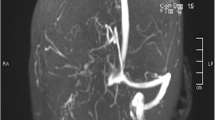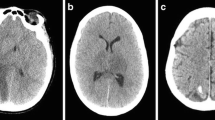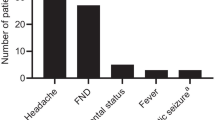Abstract
Background
Cerebral venous sinus thrombosis is an uncommon condition with many clinical manifestations, and hereditary prothrombotic conditions such as factor Leiden V, deficiency of protein S, protein C and antithrombin III, as well as prothrombin gene mutation, may account for 10–15% of cases. To date, conflicting results have been reported for recurrent venous thrombosis in the patients with factor V Leiden and prothrombin G20210A mutation, since some studies have shown a higher risk for recurrent venous thrombosis in carriers of these two mutations than in non-carriers, and the last study showed higher risk only for carriers of double defect (homozygous or double heterozygous for this mutations).
Methods
Case report is presented.
Results
We report a case of cerebral sinus thrombosis as a recurrent thrombotic event in a patient with heterozygous prothrombin G20210A genotype after discontinuation of oral anticoagulation therapy.
Conclusion
Since many facts are controversial, the use of secondary prophylaxis for thrombosis in these patients is still a matter of debate without clear consensus recommendation. Data on the risk of recurrent thrombotic events in thrombophilic patient is insufficient. The main unclear question concerning these patients is: how long and whom should we treat with long-term anticoagulant therapy as secondary prophylaxis of DVT? The problem for practitioner is that we do not have guidelines and precise recommendations for secondary thromboprophylaxis in this or similar cases. This case is remarkable for its favorable and quick outcome and its rarity, because CSVT is an uncommon condition and heterozygous prothrombin G20210A genotype was only found predisposing factor for CSVT. Further studies of risk of recurrent venous thrombosis in patients with heterozygous prothrombin G20210A genotype with the larger sample size are required.

Similar content being viewed by others
References
Allroggen H, Abbott RJ (2006) Cerebral sinus venous thrombosis. Postgrad Med J76:12–15
Masuhr F, Mehraein S, Einhaupl K (2004) Cerebral venous and sinus thrombosis. J Neurol 251(1):11–23
Rosendaal FR (1999) Venous thrombosis, a multicausal disease. Lancet 353:1167–1173
Khan S, Dickerman JD (2006) Hereditary thrombophilia. Thromb J 4:15
Koeleman BP, Reitsma PH, Bertina RM (1997) Familial thrombophilia: a complex genetic disorder. Semin Hematol 34:256–264
Emmerich J, Rosendaal FR, Cattaneo M et al (2001) Combined effect of factor V Leiden and prothrombin 20210A on the risk of venous thromboembolism. Thromb Haemost 86:809–816
Ridker PM, Hennekens CH, Miletich JP (1999) G20210A mutation in prothrombin gene and risk of myocardial infarction, stroke, and venous thrombosis in a large cohort of US men. Circulation 99(8):999–1004
Leroyer C, Mercier B, Oger E et al (1998) Prevalence of 20210 A allele of the prothrombin gene in venous thromboembolism patients. Thromb Haemost 80:49–51
Zivelin A, Rosenberg N, Faier S et al (1998) A single genetic origin for the common prothrombotic G20210A polymorphism in the prothrombin gene. Blood 92:1119–1124
Coen D, Zadro R, Honovic L, Banfic L, Stavljenic Rukavina A (2001) Prevalence and association of the factor V Leiden and prothrombin G20210A in healthy subjects and patients with venous thromboembolism. Croat Med J 42(4):488–492
Klein L, Bhardwaj V, Gebara B (2004) Cerebral venous sinus thrombosis in a neonate with homozygous prothrombin G20210A genotype. J Perinatol 24(12):797–799
Kurkowska-Jastrzebska I, Wicha W, Dowzenko A et al (2003) Concomitant heterozygous factor V Leiden mutation and homozygous prothrombin gene variant (G20210A) in patient with cerebral venous thrombosis. Med Sci Monit 9(5):41–45
Kellett MW, Martin PJ, Enevoldson TP, Brammer C, Toh CM (1998) Cerebral venous sinus thrombosis associated with 20210A mutation of the prothrombin gene. J Neurol Neurosurg Psychiatry 65(4):611–612
Reuner KH, Ruf A, Grau A et al (1998) Prothrombin gene G20210→A transition is a risk factor for cerebral venous thrombosis. Stroke 29(9):1765–1769
Mazzoleni S, Putti MC, Simioni P et al (2005) Early cerebral sinovenous thrombosis in a child with acute lymphoblastic leukemia carrying the prothrombin G20210A variant: a case report and review of the literature. Blood Coagul Fibrinolysis 16(1):43–49
Verdelho A, Ferro JM, Palmeiro A, Antunes C (2001) Cerebral venous thrombosis and familial prothrombin gene G20210a mutation. Rev Neurol 33(4):335–338
Miles JS, Miletich JP, Goldhaber SZ, Hennekens CH, Ridker PM (2001) G20210A mutation in the prothrombin gene and the risk of recurrent venous thromboembolism. J Am Coll Cardiol 37(1):215–218
Simioni P, Prandoni P, Lensing AW et al (2000) Risk for subsequent venous thromboembolic complications in carriers of the prothrombin or the factor V gene mutation with a first episode of deep-vein thrombosis. Blood 96(10):3329–3333
De Stefano V, Martinelli I, Mannucci PM et al (2001) The risk of recurrent venous thromboembolism among heterozygous carriers of the G20210A prothrombin gene mutation. Br J Haematol 13(3):630–635
Gonzalez-Porras JR, Garcia-Sanz R, Alberca I, Lopez ML, Balanzategui A, Gutierrez O et al (2006) Risk of recurrent venous thrombosis in patients with G20210A mutation in the prothrombin gene or factor V Leiden mutation. Blood Coagul Fibrinolysis 17(1):23–28
Einhaupl K, Bousser MG, de Bruijn SF, Ferro JM, Martinelli I, Masuhr F et al (2006) EFNS guideline on the treatment of cerebral venous and sinus thrombosis. Eur J Neurol 13(6):553–559
Author information
Authors and Affiliations
Corresponding author
Rights and permissions
About this article
Cite this article
Jukic, I., Titlic, M., Tonkic, A. et al. Cerebral venous sinus thrombosis as a recurrent thrombotic event in a patient with heterozygous prothrombin G20210A genotype after discontinuation of oral anticoagulation therapy: How long should we treat these patients with warfarin?. J Thromb Thrombolysis 24, 77–80 (2007). https://doi.org/10.1007/s11239-006-0005-5
Received:
Accepted:
Published:
Issue Date:
DOI: https://doi.org/10.1007/s11239-006-0005-5




